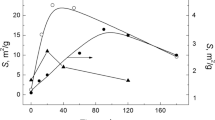Abstract
Reaction between two oxides leading to the formation of a new compound through a change in weight can be studied by TG methods. However, for catalyst preparations, in most of the cases the starting materials are not oxides. The more common methods of coprecipitation or kneading of the precipitated oxides are employed. In such cases the TG and DTG curve of the composites are of a complex nature for several possible reasons including the formation of new compounds. The interpretation of the conventional DTG curve of such a sample and identification of temperature regions for any new thermal activity thus presents problems. For such studies the use of a derived derivative thermogravimetric curve is suggested as described in this paper. This curve indicates the differences between the experimental thermal behaviour of the composite vis-a-vis theoretical thermal behaviour of the composite computed from the thermal behaviour of its constituents. The regions of a new thermal activity can be readily located and interpretated. Two systems are described, MgO-Cr2O3 and MgO-Fe2O3.
Résumé
Les méthodes thermogravimétriques (TG) permettent de suivre les réactions entre deux oxydes lorsque celles-ci s'accompagnent d'une variation pondérale et conduisent à la formation de composés nouveaux. Cependant, lors de la préparation des catalyseurs, les matériaux de départ ne sont pas, en général, des oxydes. Les méthodes les plus couramment employées sont la coprécipitation ou le malaxage des oxydes précipités. Les courbes TG et TGD des mélanges sont alors de nature complexe, pour diverses raisons, parmi celles-ci la formation de composés nouveaux. L'interprétation de la courbe TGD conventionnelle d'un tel prélèvement et l'identification des domaines de température correspondant à une activité thermique nouvelle quelconque, présentent des problèmes. On propose dans cet article d'utiliser la dérivée de la courbe thermogravimétrique dérivée pour de telles études. Cette courbe indique les différences entre le comportement thermique expérimental du composite et son comportement théorique calculé à partir de celui de ses constituants. Les régions oú une activité thermique nouvelle se manifeste sont faciles à déceler et à interpréter. Les deux systèmes suivants sont décrits: MgO-Cr2O3 et MgO-Fe2O3.
Zusammenfassung
Reaktionen zwischen zwei Oxiden, welche unter Gewichtsänderungen zur Bildung neuer Verbindungen führen, können durch TG-Methoden untersucht werden. Jedoch sind bei der Herstellung von Katalysatoren die Ausgangsstoffe in den meisten Fällen keine Oxide. Die üblichen Methoden der Mitfällung oder des Knetens der gefällten Oxide werden eingesetzt. In solchen Fällen sind die TG- und DTG-Kurven der Zusammensetzungen aus verschiedenen Gründen von komplexer Art, eingeschlossen die Bildung neuer Verbindungen. Die Deutung der konventionellen DTG-Kurve einer solchen Probe und die Identifizierung der Temperatubereiche neuer thermischer Effekte stellt in diesem Falle Probleme dar. Für solche Untersuchungen wird der Einsatz einer derivierten DTG-Kurve, wie im Artikel beschrieben, vorgeschlagen. Diese Kurve zeigt die Differenzen zwischen dem experimentellen thermischen Verhalten der Zusammensetzungen gegenüber dem theoretischen thermischen Verhalten, das aus seinen Bestandteilen errechnet worden ist. Die Bereiche einer neuen thermischen Aktivität können leicht entdeckt und gedeutet werden. Zwei Systeme, MgO-Cr2O3 und MgO-Fe2O3 werden beschrieben.
Резюме
Реакция между двумя о кисями, приводящая к образованию нового с оединения путем изменения веса, может быть изучена ТГ методами. Однако при получении катализаторов, в большинстве случае в, начальные материал ы не являются окислами. На иболее общими применяемыми методами является со осаждение или перемешивание ос адков окислов. В таких случа ях кривые ТГ и ДТГ этих составов очень сложны по приро де из-за некоторых возможных причин, включая и обра зование нового соединения. Ин терпретация обычной ДТГ кривой та кого образца и иденти фикация температурных облас тей для какойлибо новой термической ак тивности представля ет собой проблему. Для таких ис следований, как описано в настоящ ей работе, предлагает ся использовать выведе нную производную термогравиметричес кой кривой. Такая крив ая показывает различия между экспериментал ьными термическим поведен ием соединения по отношению к теоретич ескомй термическомй поведению состава, вы численному из термического поведе ния его составных частей. Области новой термической активно сти могут быть легко локализов аны и интерпретирова ны. Описаны две системы MgO-Cr2O3 и MgO-Fe2O3.
Similar content being viewed by others
References
R. K. Banerjee, B. N. Singh andB. R. Arora, Proc. 4th. ICTA, Akadémiai Kiadó, Budapest, 1975, 1, p. 452.
A. I. Vogel, Text Book of Quantitative Inorganic Analysis, Longmans Green, London 1964.
P. J. Anderson andR. F. Horlock, Trans. Farad. Soc., 58 (1962) 1993–2004.
R. C. Turner, I. Hoffmann andD. Chen, Can. J. Chem., 41 (1963) 243–51.
M. S. Kovel, Tr. Ural Politekh. Inst., 152 (1966) 5–12.
A. Bielanski, H. Boronezyk andK. Dyrek, Bull. Acad. Polon. Sci. Ser. Sci. Chim., 18 (1970) 1–8.
J.Haber and K.Hanumanlu, Trans. Indian Ceram. Soc., 6 (1969).
A. L.Mackay, Proc. Intern. Symp. Reactivity Solids, 4 th, Amsterdam, 1960, p. 571.
Soichiro Nobuoka, Kogyo Kagaku Zasshi, 68 (1965) 2311–17.
N. F. Ermolenko andT. P. Karataeva, Dokl. Akad. Nauk — Belorussk. SSR, 9 (10), (1965) 668.
T. P. Karataeva andV. V. Sviridov, Zh. Neorgan. Khim. 11 (1966) 890.
V. V.Sviridov and T. P.Karataeva, Fiz. Fiz-Khim. Soveshean F Oeritov, Mater, Dokl. Vses. Sovesheon, 4 th Minsk, (1966), p. 32.
Author information
Authors and Affiliations
Rights and permissions
About this article
Cite this article
Arora, B.R., Singh, B.N. & Banerjee, R.K. Use of derived derivative thermogravimetric curves in the compositional study of two-component oxide systems. Journal of Thermal Analysis 13, 499–508 (1978). https://doi.org/10.1007/BF01912389
Received:
Issue Date:
DOI: https://doi.org/10.1007/BF01912389



